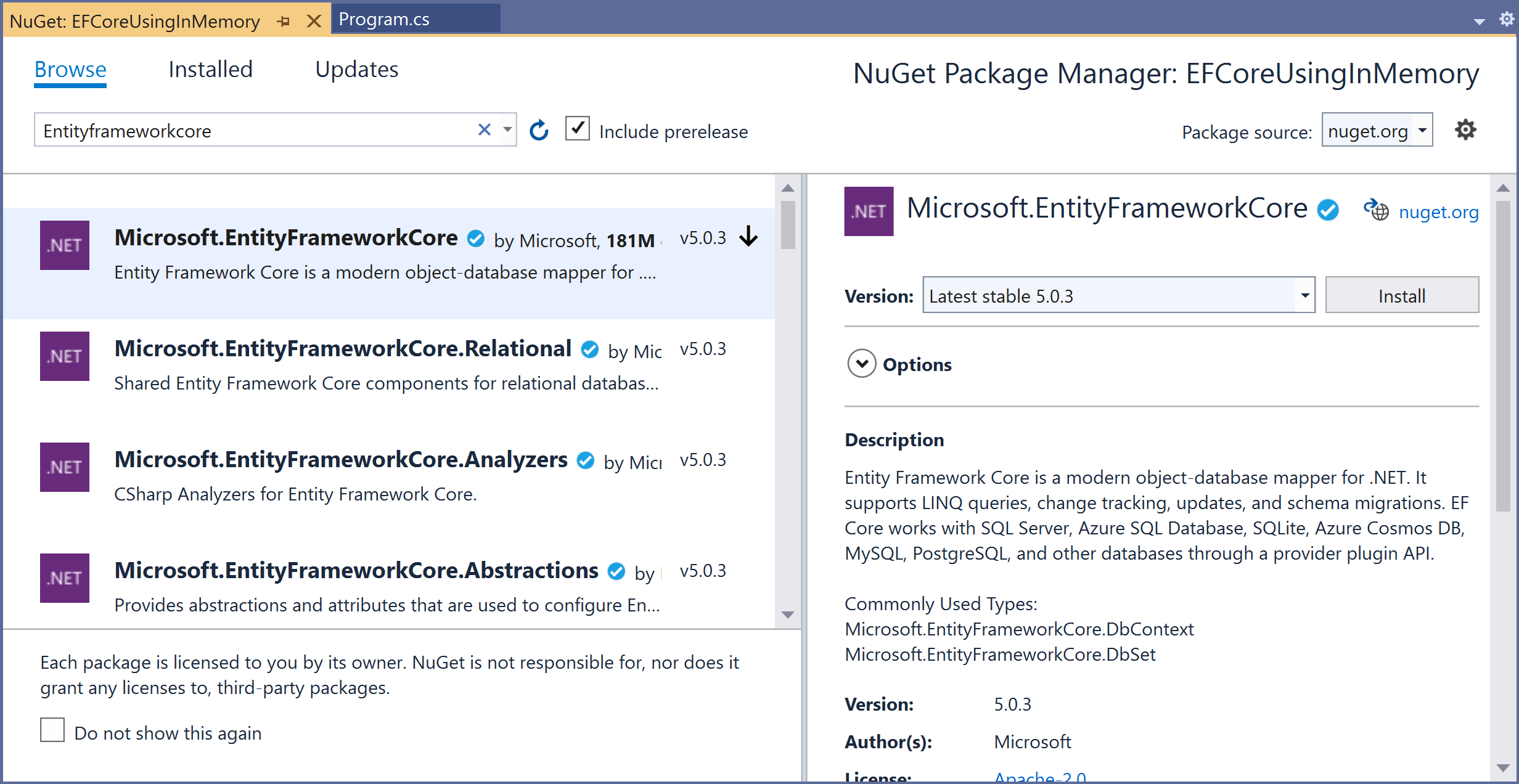EF Core Providers InMemory
InMemory is designed to be a general-purpose database for testing and is not designed to mimic a relational database.
- InMemory will allow you to save data that would violate referential integrity constraints in a relational database.
- If you use
DefaultValueSql(string)for a property in your model, this is a relational database API and will not affect when running against InMemory. - Concurrency via Timestamp/row version (
[Timestamp]orIsRowVersion) is not supported. - No
DbUpdateConcurrencyExceptionwill be thrown if an update is done using an old concurrency token.
Install Entity Framework Core
Let's create a new application using the Console App (.NET Core) template and install the following NuGet package.
In the Package Manager Console window, enter the following command.
PM> Install-Package Microsoft.EntityFrameworkCore
You can also install this NuGet package by right-clicking on your project in Solution Explorer and select Manage Nuget Packages....

Search for Microsoft.EntityFrameworkCore and install the latest version by pressing the install button.
Register EF Core Provider
For InMemory, we need to install Microsoft.EntityFrameworkCore.InMemory and will get all the packages required for EF Core.
PM> Install-Package Microsoft.EntityFrameworkCore.InMemory
Now, you are ready to start your application.
Create Data Model
Model is a collection of classes to interact with the database.
- A model stores data that is retrieved according to the commands from the Controller and displayed in the View.
- It can also be used to manipulate the data to implement the business logic.
To create a data model for our application, we will start with the following two entities.
public class Author
{
public int AuthorId { get; set; }
public string FirstName { get; set; }
public string LastName { get; set; }
public DateTime BirthDate { get; set; }
public List<Book> Books { get; set; }
}
public class Book
{
public int BookId { get; set; }
public string Title { get; set; }
public Author Author { get; set; }
}
There's a one-to-many relationship between Author and Book entities. In other words, an author can write any number of books, and only one author can write a book.
Create Database Context
The database context class provides the main functionality to coordinate Entity Framework with a given data model.
- You create this class by deriving from the
System.Data.Entity.DbContextclass. - In your code, you specify which entities are included in the data model.
- You can also customize certain Entity Framework behaviors.
So, let's add a new BookStore class that will inherit the DbContext class.
public class BookStore : DbContext
{
protected override void OnConfiguring(DbContextOptionsBuilder optionsBuilder)
{
optionsBuilder.UseInMemoryDatabase(databaseName: "BookStoreDb");
}
public DbSet<Author> Authors { get; set; }
public DbSet<Book> Books { get; set; }
}
In EF Core, the DbContext has a virtual method called OnConfiguring, which will get called internally by EF Core.
- It will pass in an
DbContextOptionsBuilderinstance, which can be used to configure options for theDbContext. - The
DbContextOptionsBuilderhasUseInMemoryDatabasemethod, which expects a connection string as a parameter.
Now, we are done with the required classes, let's add some authors and book records to the InMemory database and then retrieve them.
using (var context = new BookStore())
{
context.Database.EnsureDeleted();
context.Database.EnsureCreated();
var authors = new List<Author>
{
new Author
{
FirstName ="Carson",
LastName ="Alexander",
BirthDate = DateTime.Parse("1985-09-01"),
Books = new List<Book>()
{
new Book { Title = "Introduction to Machine Learning"},
new Book { Title = "Advanced Topics on Machine Learning"},
new Book { Title = "Introduction to Computing"}
}
},
new Author
{
FirstName ="Meredith",
LastName ="Alonso",
BirthDate = DateTime.Parse("1970-09-01"),
Books = new List<Book>()
{
new Book { Title = "Introduction to Microeconomics"}
}
},
new Author
{
FirstName ="Arturo",
LastName ="Anand",
BirthDate = DateTime.Parse("1963-09-01"),
Books = new List<Book>()
{
new Book { Title = "Calculus I"},
new Book { Title = "Calculus II"}
}
}
};
context.Authors.AddRange(authors);
context.SaveChanges();
}
using (var context = new BookStore())
{
var list = context.Authors
.Include(a => a.Books)
.ToList();
foreach (var author in list)
{
Console.WriteLine(author.FirstName + " " + author.LastName);
foreach (var book in author.Books)
{
Console.WriteLine("\t" + book.Title);
}
}
}
If you run the application, you will see that authors and books are successfully inserted into the database and also printed on the console.
Carson Alexander
Introduction to Machine Learning
Advanced Topics on Machine Learning
Introduction to Computing
Meredith Alonso
Introduction to Microeconomics
Arturo Anand
Calculus I
Calculus II
